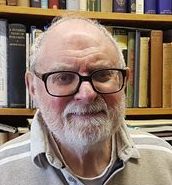Valediction No.3: Book Ends
Brian Alderson is bidding a fond farewell to the books that make up his extraordinary collection, which is being presented to Seven Stories. Here he packs up copies of Isaac Watts’ Divine Songs.
In 1964 I commenced as editor of The Juvenile Library, a (predictably unsuccessful) series of facsimiles of some notable early children’s books that were much written about but difficult to come by outside special libraries.
I got the idea from Mary Thwaite, former County Librarian of Hertfordshire and children’s book historian. She would give talks on the subject and had made for her own use a typescript copy (which she had had neatly bound) (1) of one of the most famous of children’s literature’s incunabula, John Newbery’s Little Pretty Pocket-Book (1744). She lent me the copy which I showed to Mabel George, the famed children’s books editor at Oxford’s London office and the series was founded with Mary editing the Newbery for it.
As we devised it, the facsimiles were sandwiched between an Introduction setting out the circumstances of the book’s production and concluding bibliographies which would trace subsequent editions and similar matter. It was not perhaps a good idea and the TLS reviewer, who was surely Sydney Roscoe, the great Newbery (and Bewick) authority, wrote of it as ‘breaking a butterfly on the wheel’.
One scholar at least liked the idea and he wrote in to suggest that we might include in the series the immensely rare first edition of Isaac Watts’s Divine Songs Attempted in Easy Language for the Use of Children, published in 1715 and never out of print as a children’s book until the beginning of the twentieth century. Our correspondent was J.H.P. (Jack) Pafford who was at that time Goldsmith’s Librarian at the University of London and his suggestion stemmed in part from the fact that both he and his wife knew the book from their own childhoods.
There was, of course, no alternative but to ask Jack to take on the job (the book was on our list anyway) but he was horrified to learn that he would have to include a bibliography. As you may guess, a book of simple verses by a renowned hymnologist, appealing to no particular class or party, had all the ingredients for commercial success and for more than a hundred years beyond the ending of its copyright the book made for easy sales for publishers throughout the land (evidence for its popularity is now frequently cited through the two parodies that Carroll put into Alice’s Adventures in Wonderland).
In the event, Jack bent his back to the task and as both scholar and bibliographer honoured our book with a near definitive analysis dependent on the sight of as many copies and variants as possible. From then on, indeed, I have collected over seventy examples both ‘in’ and ‘not in’ Pafford which amount to an exhibition of examples of nineteenth century book production: textual variants, formats, illustrations, plain and coloured, bindings etc.
I shall be sorry to say good-bye to the lot since much remains to be done to assess the not overly joyous texts as they passed through the hands of provincial and London publishers and especially their illustrators.
Foremost among these is Georgie Gaskin’s unique and charming ‘arts and crafts’ presentation with all the divine songs but, despite its title, none of the moral ones. The book was a complex job with its many inset plates and their almost child-like artistry whose set design are a tribute to Evans’s colour printing in the new age of half-tone colour. (Elkin Mathews, be it noted, would soon also be one of the first of Ezra Pound’s publishers.)
If this pretty book can be seen as the last of the illustrated editions then the first, which boasts only a frontispiece, must not only be labelled ‘not in Pafford’ but is known perhaps in only two or three copies. Its Southampton publisher may have produced it since Watts was a native of that city (where its former owner, Gerry Bell, a notable collector of children’s books, was Professor of Chemistry). In view of its eventual destination we should also record that another former owner, J.Cresswell, was a Newcastle man whose book-plate derives from the Bewick workshop
Isaac Watts Divine Songs Attempted in Easy Language for the Use of Childen…to which are added supplementary poems by Dr Doddridge &c. Southampton: Printed and sold by T.Baker. Sold also by all the Booksellers in Great Britain and Ireland. (Price Six-pence) MDCCLXXVII. 12mo.100x75mm. unsigned frontis.,xii, 13-90pp. Dutch flowered paper over boards. Provenance: J.Cresswell (typographic slug in woodcut from the Bewick workshop; see Tattersfield Bookplates pp.105 & 182); Dening Coll.;Ella Dagger Robson from her grand Pa 1908;Gerry Bell; John Windle. (Cotsen AII1243 ; Oppenheimer 2650. Not in Pafford; not in ESTC)
ibid DIVINE AND MORAL SONGS FOR CHILDREN BY THE REVEREND ISAAC WATTS [framed col.illus of a child praying] ELKIN MATHEWS, VIGO ST. LONDON [1896]. sq.12mo. 147x120mm. Frontis, 64pp.+ 12 insets (p.1 half-title: Divine and Moral Songs by the Rev. Isaac Watts D.D. with coloured pictues by Mrs Arthur Gaskin; p.3 dedication: These little pictures are dedicated to MY HUSBAND by his pupil and wife; p.64 imprint: London. Engraved and printed at the Racquet Court Press by Edmund Evans.)
(1) The copy is now in the Philip Robinson Library at Newcastle University Library.
 Brian Alderson is a long-time and much-valued contributor to Books for Keeps, founder of the Children’s Books History Society and a former Children’s Books Editor for The Times. His most recent book The 100 Best Children’s Books is published by Galileo Publishing, 978-1903385982, £14.99 hbk.
Brian Alderson is a long-time and much-valued contributor to Books for Keeps, founder of the Children’s Books History Society and a former Children’s Books Editor for The Times. His most recent book The 100 Best Children’s Books is published by Galileo Publishing, 978-1903385982, £14.99 hbk.





